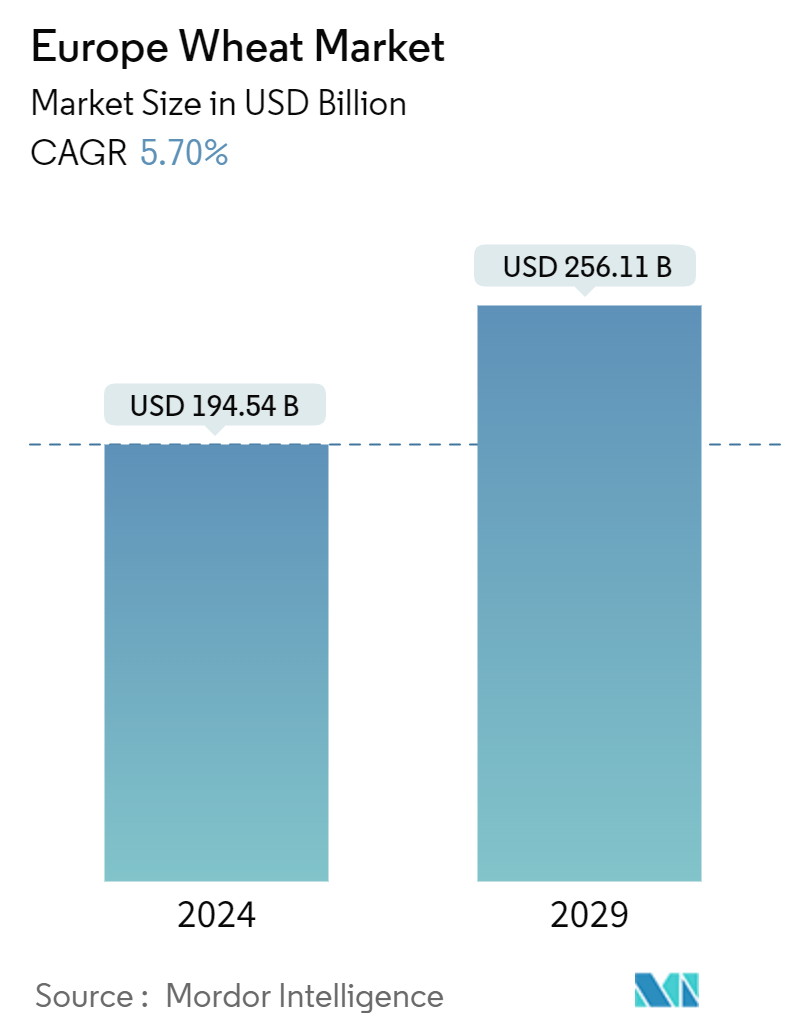Market Size of Europe Wheat Industry

| Study Period | 2019 - 2029 |
| Base Year For Estimation | 2023 |
| Forecast Data Period | 2024 - 2029 |
| Market Size (2024) | USD 194.54 Billion |
| Market Size (2029) | USD 256.11 Billion |
| CAGR (2024 - 2029) | 5.70 % |
Europe Wheat Market Analysis
The Europe Wheat Market size is estimated at USD 194.54 billion in 2024, and is expected to reach USD 256.11 billion by 2029, growing at a CAGR of 5.70% during the forecast period (2024-2029).
Europe emerged as the world's leading wheat producer, contributing 282.7 million metric tons, as reported by the FAO during the year 2022. Eurostat data highlights France as the European Union's foremost wheat producer, with a yield of 34.6 million tons in 2022. Germany followed with a production of 22.7 million tons, while Poland contributed 13.2 million tons. Spain and Italy share the fifth spot among the European Union's top producers. Notably, wheat constitutes over half of the cereals grown in the region. The rising demand for wheat and wheat flour is largely attributed to a growing consumer preference for processed and convenience foods. Wheat flour plays a crucial role in enhancing the texture and profile of various convenience food items, including bakery products, snacks, and ready-to-eat meals. As the food & beverages industry expands and economic conditions improve, there's a noticeable shift towards convenience foods among consumers in both developed and developing European nations, driving the market's growth.
In recent years, there's been a marked increase in the region's consumption of ready-to-eat food and beverages, further fueling the demand for convenience foods. For example, data from the Office for National Statistics (UK) reveals that in 2022, sales of prepared meals and dishes surged to approximately GBP 3.82 billion (USD 4.71 billion), up from GBP 3.51 billion (USD 4.50 billion) in 2020. This rising demand for convenience food items is set to drive the need for wheat and wheat flour. Across Europe, convenience foods are increasingly catering to the surging food demand.
In 2022, European wheat prices were buoyed by renewed demand and bargain buying, especially in the absence of US market influences. Traders, however, remained skeptical of Russia's move to reduce its grain export tax, aiming to make its wheat more competitive globally. In response to the surging demands, companies are focusing on enhancing grain quality and optimizing distribution channels to cater to a wider customer base.
Europe Wheat Industry Segmentation
Wheat is a grass widely cultivated for its seed, a cereal grain that is a worldwide staple food and is ground to make flour for bread, pasta, pastry, etc. The Europe Wheat Market is segmented by Geography into Spain, France, United Kingdom, Germany, and Russia. The report includes production (volume), consumption (volume and value), import (volume and value), export (volume and value), and price trend analyses. The report offers market estimation and forecasts value in (USD) and volume (metric tons) for the above segments.
| Geography (Production Analysis in Volume, Consumption Analysis by Volume and Value, Import Analysis by Value and Volume, Export Analysis by Value and Volume, and Price Trend Analysis) | |
| Spain | |
| France | |
| United Kingdom | |
| Germany | |
| Russia |
Europe Wheat Market Size Summary
The wheat market in Europe is experiencing significant growth, driven by the region's status as the largest global producer of wheat. This staple crop is integral to the European diet, with a substantial portion of cereals grown being wheat. The increasing consumer preference for processed and convenience foods, such as bakery products and ready-to-eat meals, is fueling demand for wheat and wheat flour. This trend is further supported by the expanding food and beverage industry and improving economic conditions across both developed and developing European countries. As urbanization continues to influence consumption patterns, there is a noticeable shift towards convenience foods, which in turn is boosting wheat consumption. The market is also benefiting from enhanced quality of grain and efficient distribution channels, ensuring a broader customer base is served.
Russia plays a pivotal role in the European wheat market, being the highest producer and a leading exporter globally. The country's vast agricultural land, particularly in the black soil region, is conducive to wheat cultivation, and its production is expected to rise due to extensive unused land resources and significant yield gaps. Despite potential challenges posed by climate change, Russia's dominance in production and exports remains strong, with major importers like Turkey, Egypt, Azerbaijan, and Nigeria relying heavily on Russian wheat. The European wheat market's growth is further bolstered by initiatives such as RAGT Seed Group's development of resilient wheat varieties and Nestle's sustainable farming practices, which aim to enhance agricultural sustainability and productivity.
Europe Wheat Market Size - Table of Contents
-
1. MARKET DYNAMICS
-
1.1 Market Overview
-
1.2 Market Drivers
-
1.2.1 Increasing Government Support
-
1.2.2 Increasing Consumption of Wheat Leads to Higher Imports
-
1.2.3 Rising Demand for Wheat-Based Products
-
-
1.3 Market Restraints
-
1.3.1 Unfavorable Climatic Conditions
-
1.3.2 Rising Pest and Disease Infestations
-
-
1.4 Value Chain Analysis
-
-
2. MARKET SEGMENTATION
-
2.1 Geography (Production Analysis in Volume, Consumption Analysis by Volume and Value, Import Analysis by Value and Volume, Export Analysis by Value and Volume, and Price Trend Analysis)
-
2.1.1 Spain
-
2.1.2 France
-
2.1.3 United Kingdom
-
2.1.4 Germany
-
2.1.5 Russia
-
-
Europe Wheat Market Size FAQs
How big is the Europe Wheat Market?
The Europe Wheat Market size is expected to reach USD 194.54 billion in 2024 and grow at a CAGR of 5.70% to reach USD 256.11 billion by 2029.
What is the current Europe Wheat Market size?
In 2024, the Europe Wheat Market size is expected to reach USD 194.54 billion.

